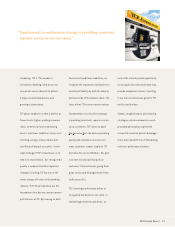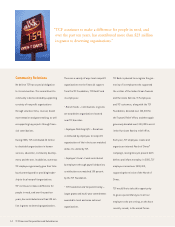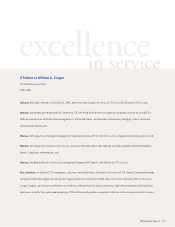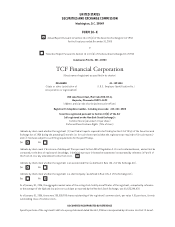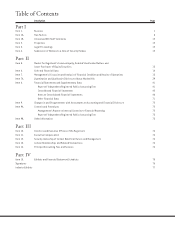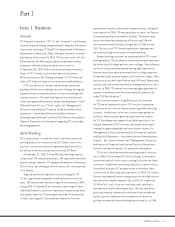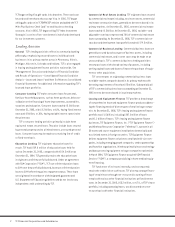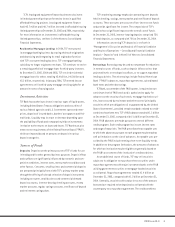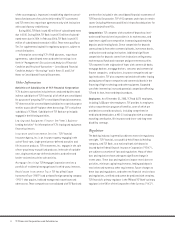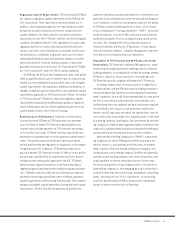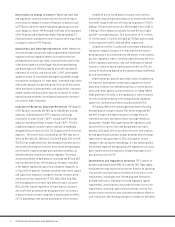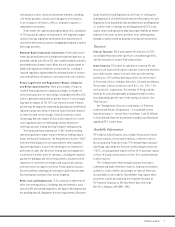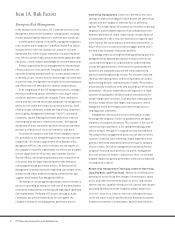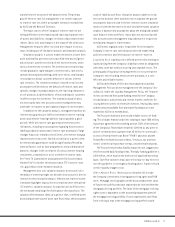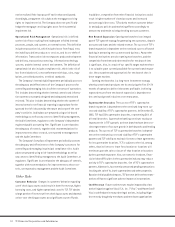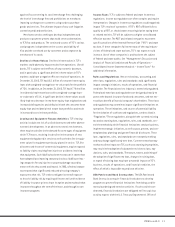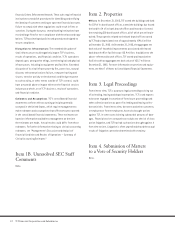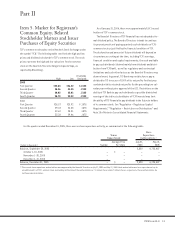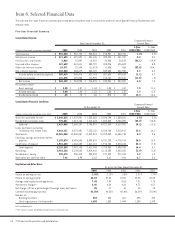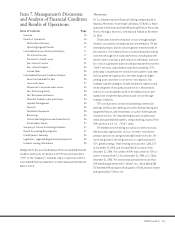TCF Bank 2005 Annual Report Download - page 25
Download and view the complete annual report
Please find page 25 of the 2005 TCF Bank annual report below. You can navigate through the pages in the report by either clicking on the pages listed below, or by using the keyword search tool below to find specific information within the annual report.
52005 Form 10-K
Regulatory Capital Requirements TCF Financial and TCF Bank
are subject to regulatory capital requirements of the FRB and the
OCC, respectively. These requirements are described below. In
addition, these regulatory agencies are required by law to take
prompt action when institutions do not meet certain minimum
capital standards. The Federal Deposit Insurance Corporation
Improvement Act of 1991 (“FDICIA”) defines five levels of capital
condition, the highest of which is “well-capitalized.” It requires that
regulatory authorities subject undercapitalized institutions to
various restrictions such as limitations on dividends or other capi-
tal distributions, limitations on growth or activity restrictions.
Undercapitalized banks must also develop a capital restoration
plan and the parent financial holding company is required to
guarantee compliance with the plan. TCF Financial and TCF Bank
are “well-capitalized” under the FDICIA capital standards.
The FRB and the OCC also have adopted rules that could permit
them to quantify and account for interest-rate risk exposure and
market risk from trading activity and reflect these risks in higher
capital requirements. New legislation, additional rulemaking, or
changes in regulatory policies may affect future regulatory capital
requirements applicable to TCF Financial and TCF Bank. The ability
of TCF Financial and TCF Bank to comply with regulatory capital
requirements may be adversely affected by legislative changes or
future rulemaking or policies of their regulatory authorities or by
unanticipated losses or lower levels of earnings.
Restrictions on Distributions Dividends or other capital
distributions from TCF Bank to TCF Financial are an important
source of funds to enable TCF Financial to pay dividends on its
common stock, to make payments on TCF Financial’s borrowings,
or for its other cash needs. TCF Bank’s ability to pay dividends is
dependent on regulatory policies and regulatory capital require-
ments. The ability to pay such dividends in the future may be
adversely affected by new legislation or regulations, or by changes
in regulatory policies. In general, TCF Bank may not declare or
pay a dividend to TCF Financial in excess of 100% of its net profits
during a year combined with its retained net profits for the pre-
ceding two years without prior approval of the OCC. TCF Bank’s
ability to make capital distributions in the future may require
regulatory approval and may be restricted by its regulatory author-
ities. TCF Bank’s ability to make any such distributions may also
depend on its earnings and ability to meet minimum regulatory
capital requirements in effect during future periods. These capital
adequacy standards may be higher than existing minimum capital
requirements. The OCC also has the authority to prohibit the
payment of dividends by a national bank when it determines such
payments would constitute an unsafe and unsound banking prac-
tice. In addition, income tax considerations may limit the ability
of TCF Bank to make dividend payments in excess of its current
and accumulated tax “earnings and profits” (“E&P”). Annual div-
idend distributions in excess of E&P could result in a tax liability
based on the amount of excess earnings distributed and current
tax rates. See “Management’s Discussion and Analysis of
Financial Condition and Results of Operations — Consolidated
Financial Condition Analysis – Liquidity Management” and Note
14 of Notes to Consolidated Financial Statements.
Regulation of TCF Financial and Affiliates and Insider
Transactions TCF Financial is subject to FRB regulations, exami-
nations and reporting requirements relating to bank or financial
holding companies. As a subsidiary of a financial holding company,
TCF Bank is subject to certain restrictions in its dealings with
TCF Financial and with companies affiliated with TCF Financial.
A holding company must serve as a source of strength for its
subsidiary banks, and the FRB may require a holding company to
contribute additional capital to an undercapitalized subsidiary
bank. In addition, Section 55 of the National Bank Act may permit
the OCC to order the pro rata assessment of shareholders of a
national bank where the capital of the bank has become impaired.
If a shareholder fails to pay such an assessment within three
months, the OCC may order the sale of the shareholder’s stock to
cover a deficiency in the capital of a subsidiary bank. In the event
of a holding company’s bankruptcy, any commitment by the hold-
ing company to a federal bank regulatory agency to maintain the
capital of a subsidiary bank would be assumed by the bankruptcy
trustee and may be entitled to priority over other creditors.
Under the Bank Holding Company Act (“BHCA”), a bank hold-
ing company must obtain FRB approval before acquiring more
than 5% control, or substantially all of the assets, of another
bank, or bank or financial holding company, or merging or con-
solidating with such a holding company. The BHCA also generally
prohibits a bank holding company, with certain exceptions, from
acquiring direct or indirect ownership or control of more than
5% of the voting shares of any company which is not a bank or
bank holding company, or from engaging directly or indirectly in
activities other than those of banking, managing or controlling
banks, providing services for its subsidiaries, or conducting
activities permitted by the FRB as being closely related and
proper incidents to the business of banking.


